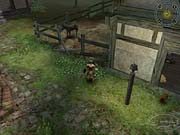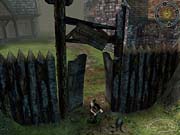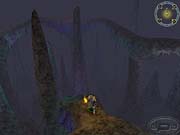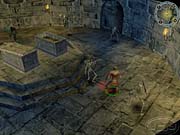Dungeon Siege Q&A
We talk to Dungeon Siege creator Chris Taylor to get a progress report on his upcoming RPG.

Chris Taylor, the creator of the hugely popular real-time strategy game Total Annihilation, has been very busy. Not only has he founded his own game company called Gas Powered Games, but he is also working on an innovative role-playing game called Dungeon Siege. RPGs are now one of the most popular, if not the most popular genres in gaming. Taylor's Dungeon Siege, though, isn't just rehashing the conventions of other RPGs. In fact, one of the best things about this game is that it takes all the nagging problems of RPGs that no one has ever dealt with, such as why you can't ever carry more treasure or why you can't just combine two half-full potion flasks to save space or why you can't hire some henchmen fodder, and addresses them. The game also has a state-of-the-art 3D engine, and a seamless world where transitions from dungeons to wilderness are instantaneous. There is obviously much more to this ambitious game, so we sat down with Chris Taylor to ask him a few questions about his upcoming role-playing game, and get four new screens.
GameSpot: How is development progressing on Dungeon Siege? What sort of milestones have you recently met?
Chris Taylor: Development is always a wild ride, but given that this is an RPG, I would say it's going pretty darn good. We have quite a few milestones on this project given the size and scope, but we are only a few away from "code complete." This is where all the features are in the game and only require debugging, which can take quite a lot of work.
GS: For those who don't know, explain how Dungeon Siege differs from other role-playing games?

GS: Some people assume that your RPG will have more real-time strategy elements, because you created Total Annihilation. Will Dungeon Siege have any such elements or is it a pure role-playing game?
CT: Most of the elements we borrow from RTS games are in the interface, but in the overall feel of the game there are many strategic elements. For example, the player should keep the heavily armored fighters out in front, followed by archers and magic users. This kind of strategic planning with a good formation will go a long way toward keeping the casualties to a minimum.
GS: What are the character classes in the game and what are some of their distinguishing abilities?
CT: We have what we call a skill-based class system. This means the players can define the character's class by the skills they learn as they adventure through the world. The core skills are those of a fighter, magic-user and archer. The players can mix or match these any way they want and can start developing a skill at any time in the game. One of our overarching goals is to make our class system as simple as possible [while also giving] maximum flexibility to the player. Translation: No bizarre rules!
Seamless Worlds, Backstory, and More

CT: A seamless world is one that does not stop the game action to load a new area in the world. This includes new outdoor and indoor areas as the player comes across them. For example, when the player enters a dungeon, we fade away everything except the dungeon itself. We also fade the roofs off of buildings and any other structure the player may want to enter without pausing the action. When moving across large outdoor areas that seem to span miles. The world just keeps going and going.
GS: What sorts of environments can we expect to see in the game? And will these environments actually affect the gameplay - such as slippery footing on icy terrain or reduced visibility in fog?
CT: We do have wind, rain, and snow, although at this time only the wind has an effect on the game's projectile weapons. And yes, we do use fog to reduce the visibility in certain areas, both indoor and outdoor. Most of the other environment variables are [determined] by the actual terrain and how the world is laid out. For example, approaching a group of monsters from higher ground gives you a tactical advantage. Perhaps I should mention that it is a safe world, and all surfaces have a special no-slip rubbercoating. You wouldn't want to get hurt saving the world would you?
GS: What is the backstory to the game?

GS: There hasn't been a lot of info about the actual gameworld and events. What sort of forces and characters are shaping the world of Dungeon Siege?
CT: Since Dungeon Siege is one gigantic continuous world, it gave us an opportunity to create an adventure that begins the moment the game starts. The events begin right away with the hero's farmhouse under attack. The players needs to defend their home, find their way to town and find out what is happening in the world. We don't tell the whole story at once. We use the mystery format, letting them know a little at a time. About halfway through the game you start to see the whole picture and find out who is behind all of these attacks.
GS: How does the game scale to the player? You mention that you can choose to adventure with ten characters, or go it solo with lots of pack animals and a few henchmen. How will the game adjust for the different types of play and make sure the game is challenging but survivable no matter how you play?
CT: That's a good question, and it's explainable by thinking about the way characters accumulate experience points and develop skills. If you have a few characters that get all the experience, they will develop themselves more than if these same points were shared by a larger group. At one extreme, imagine a single character soaking up all the experience, gold, and cool items, and because of this, being one super tough character! You can see that it does actually pay in some cases to take on the world alone. It will be a very different game experience depending on how many characters are in the player's party.
GS: You're pretty excited about the Siege Editor that is shipping with the game. Explain what is so cool about it.
CT: The Siege Editor allows players to build their own custom worlds. The Siege engine is completely data driven, allowing players to create almost any kind of new content that they can think of including new game experiences for both the single and multi-player games. It's really going to be great to see what people are going to come up with.
GS: When can we expect to play Dungeon Siege?
CT: Currently we are on track for a summer-fall 2001 release.
Got a news tip or want to contact us directly? Email news@gamespot.com
Join the conversation